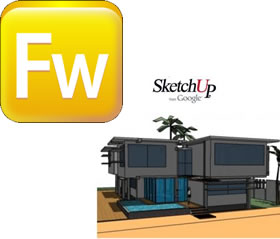Workshops/Composing Simple 2D and 3D Diagrams for Online Delivery
Session Information
- Level - Introductory, no previous experience with Adobe Fireworks or Google SketchUp required
- Audience - Instructors interested in creating simple 2D and 3D diagrams for online delivery
- Time - 50 minutes
Before the Session
This session is hands-on, so please bring your laptop if possible. If you cannot bring a laptop, one will be provided for you.
General Description
WSU licenses Adobe Creative Suite (CS) which provides all instructors with access to a very powerful set of tools for visualizing class concepts and creating visual content that can be easily published online. Adobe Fireworks is one tool in the CS package. Less complex than Photoshop and designed specifically for creating graphics for Web distribution, Fireworks is a great 2D drawing and image editing tool that can be learned quickly. In this session, you will learn the basics of Fireworks by creating several simple diagrams and publishing them online. In some cases, a 3D image is required to communicate a concept effectively. Google SketchUp is a free 3D image authoring tool that can be used to create standalone models as well as content that can be added to Google Earth. Learn the basics of Google SketchUp by creating several simple 3D diagrams.
Learning Outcomes
Following this session, you will be able to...
- Install Fireworks and SketchUp on your laptop and/or home computer
- Create basic 2D diagrams for your courses using Fireworks
- Apply fill colors and patters to objects in Fireworks
- Add, format, and position text in Fireworks
- Group objects in Fireworks
- Size the fireworks canvas and image
- Add simple effects (e.g., drop shadows) to Fireworks objects
- Export Fireworks diagrams to various Web-friendly formats
- Orbit, zoom, and pan SketchUp models
- Create 2D SketchUp objects and pull them in to 3D
- Infer and heal edges of SketchUp surfaces
- Use inference points to construct surfaces
- Save SketchUp models as 2D images
